Mary Beard's Blog, page 63
September 1, 2011
Fed up with the REF... and what about the babies?

In case you don't know the "REF" (the Research Excellence Framework, which sounds like the higher education of a "record of achievement") is the new version of the RAE (the Research Assessment Exercise, which was at least honest enough to admit that it was judgmental.. more like the old "school report"). It is the process by which the government evaluates the research "output" of University departments (and indeed of the individual academics within those departments) and then distributes (or not) money accordingly.
No surprise that I have little sympathy with this process. It's not that I think university academics should not be in some form accountable to those who (in large part, but not wholly) pay for them. But this process is overall a block on good, imaginative research in the humanities (and maybe in the sciences too). It dominates the thinking of University administrators (try appointing someone to a university job who -- whatever good reason -- doesn't look as if they are going to have a "robust" submission (that is new uni speak even among the dreaming spires) for the REF). And it sets a load of ingenious people off on the chase of clever ways to come out on top.. so that the government can thrash us all, or rather some of us, again. Divide and rule, it used to be called.
No department wants to be a three star (or whatever it will be called this time), else some slasher VC will come in and slash them (or, if they are VERY LUCKY INDEED, will give them extra research leave, and two new super-star colleagues (no teaching duties) so they can do better next time... dream on).
I realise, of course, that many of my own colleagues have done valiant jobs and spent weeks of their life in evaluating all this research activity in past assessement exercises, to ensure that the process is still a peer review, not some metric exercise -- which would reward the popular and bad (or to be fair the popular and good) at the expense of the brilliant and unfashionable. (A bit like Cambridge University Library thinking you can judge the value of a periodical on the basis of how many times it has been borrowed..). Dont think I'm ungrateful to them. But all the same, I dont like the system.
Today though, it isn't the higher principles, or "the system, that are annoying me. It is what the REF has done to my summer.
Now I haven't been research inactive over the last few years; indeed I have written a lot, had quite a bit of "impact" (another bit of uni new speak) and I have given two big series of lectures in the states (Sathers and Mellons) which took a hell of a lot of work to do, which other people would long to give and which I am dying to write up. What I wanted to do this summer was to get down to Roman Laughter (the Sather topic) and get it pretty well finished .. but hang on.
I have to submit 4 'outputs published between 2008 and the end of 2013. My Pompeii book is an obvious one, as is a big article about to come out on 19th century travel to Pompeii. After that I have a variety of things, including a new article in an exhibition catalogue on the secret cabinet in the Naples Museum, a total re-write of a piece on "Oriental Cults" I did a years ago (this is effectively a new paper, but will it count?), some stuff on Roman Britain in the late 19th century, plus a Darwin lecture on Risk... and a paper on Samuel Butler that didnt actually apear till 2008, although it was supposed to be out in 2007 etc etc.
What I ought to have done this summer was get down and conquer my Laughter book. That would have made the most intellectual sense, and it would have been best for the subject, and for me. But I sat down and thought, hell -- if I get to it now, it still might not come out by the end of 2013, there might be all kinds of hold ups, and the University of California Press doesnt quite get the REF issue...
What I need to be safe, I thought, is another sure fire article. So I wrote an article on the History of the Fitzwilliam Classical Collection, which I have enjoyed (a lot actually), and which I had promised... but in the end I only really did it because of the damn REF, when I should have spent the summer on Laughter.
So if anyone ever tells you that the REF doesnt skew people's research plans, I for one can tell you that it does.
Then just as I was reflecting gloomily on this subject, I was told that the most recent consultative document for the rules for the REF proposes normally giving women who have had kids no allowance in the evaluation unless they have had more than 14 months maternity leave in the 5 years (for most of us, who cant afford unpaid maternity leave, that would mean having had 3 kids in 5 years). The idea is supposed to be that you have your maternity leave and then are back to normal.(An alternative and, in my view, much better suggestion would be to credit women with an output for each baby... so one child born in the period and you would only need 3 outputs, 2 and you would only need 2).
This idea of not recognising the research effects of young babies is surely mad. I have tried writing articles with two kids under 3. It isnt about just the official maternity leave. What you need to write good articles and books in my subjects is uninterruptted thinking time. So what blights your productivity for a good while are the trips backward and forwards to feed the baby, the fact that you cant go to all those seminars you used to go to (people forget about you and what you might be doing), and you certainly cant go to conferences (unless you fancy sitting in the bog and expressing the milk for what seems like hours on end, while everyone else is networking).
If there had been an REF on these terms in the mid 1980s, I would have been a casualty (ie I would have been a failure).. and I probably would have left the University and got another job. 20 years on (and it takes 20 years) I am confident enough to say that that would have been a loss.
Where are our equal opps people when we need them?
August 29, 2011
The anti-Power-Point party

I hope this isn't going to come across as Luddite as it might sound. But let me draw your attention to the anti-Power-Point party in Switzerland (which claims that it will save £350bn globally if we ditch PPT.. not quite sure how, but surely a good thing for the world).
I confess that I rather like some aspects of PPT. I constructed what I thought of as great slide shows in Washington DC for my NGA lectures -- entirely with PPT(though it took as long to make the PPT as it did to write the lectures) .. Credit where it's due: Therese and Mattie were very strict on the quality control of the slides (no crap images please)... and I refer you to them for further info. But that was just slides and captions, no bullet points. Indeed T and M were pretty suspicious even about the presence of captions.
But my question is: what next? I dont mean, how many pictures can you get to zoom across the screen apparently unaided, and explode in one corner to a welter of on line cheers... I am far behind that.
 What worries me (and why I am half behind this Swiss party) is the way that PPT has influenced everything else we do, and the way we process and present information (how PPT impacts on the classification of knowledge..). I have been to several presentations -- from members of the University HR department, among others -- in the last few months, in which the speaker has come along with some kind of handout that s/he has presented to us In the more glitzy presentations, this has been expensively printed out and carefully bound up.
What worries me (and why I am half behind this Swiss party) is the way that PPT has influenced everything else we do, and the way we process and present information (how PPT impacts on the classification of knowledge..). I have been to several presentations -- from members of the University HR department, among others -- in the last few months, in which the speaker has come along with some kind of handout that s/he has presented to us In the more glitzy presentations, this has been expensively printed out and carefully bound up.
But it has been clear enough, at first glance, that these pages have been powerpoint slides printed out, and re-turned to text. We didn't indeed need the speaker to say "if you look at the next slide..." (as they repeatedly did), when what we we had in front of us was a piece of paper that had been printed out from a slide... and they really meant "page".
Why do it? At least 50% of people in the room are angry. They are angry at the cliché logos you have at the corner, at the bullet points, and at the enshrined spelling mistakes (aagghh)....Why not just talk to us/them, rather than fire the bullet points (and all the simplistic stuff that goes with them)?
My advice to anyone going for an interview would be to leave the PPT (and its simplistic props) behind. Say what you have to say and leave it at that. I mean, most of the people you are trying to impress are not HR; theyare late middled aged academics like me!
Any ideas about how to resist this encroachment?
August 25, 2011
Gaddafi's Roman home -- or not?

One strange thing for me over weeks of the Libyan War has been the all the bells of ancient North Africa that it has rung. I have never been to Libya (though my old Director of Studies -- who is getting better after the hospital stay, by the way -- has spent many years studying its Roman inscriptions), and so I have found myself matching up all the places of conflict to the ancient map in my head.
Some of this was easy enough. Tripoli has a good old ancient name: "Tri -- polis" = "three cities", and the name goes back to the Roman name given to the region under the empire, "Tripolitania" -- the three cities being Oea (on the site of what we call Tripoli), Lepcis (or Leptis) Magna and Sabratha.
There is not very much Roman to see (I'm told) in Tripoli. But Sabratha has a tremendous theatre, and Lepcis was the original home of the Roman emperor Septimius Severus (whose rise to, and tenure of, power was not all that much less bloody than Gaddafi's). It's the ancient Roman site that I feel most guilty not to have actually seen, because Septimius poured money into the place -- and it has what are (as you see above) some of the best preserved Roman buildings anywhere (though rather more helped by the restorers of Mussolini -- another dictator who was elbows deep in Libya -- than we like to imagine).
So far, so good. But I have got terribly mixed up with Gaddafi's home town of Sirte.
Most of the week I have been going round claiming another bit of Roman geneaology for the Colonel. I assumed (not unreasonably, I think) that what the radio was calling "Sirte" was what I called "Cirta".This was one of the places where Scipio defeated the allies of Carthage (led by Syphax) in the Second Punic War in 203 BC, but I thought I knew it better as the place where an early Christian House-Church was ransacked during the Persecutions of Diocletian in the early fourth century CE -- described in detail in an early Christian text (Gesta apud Zenophilum... which if you want to know comes as an appendix to Optatus of Mileve). It's particularly interesting for the information it gives us about the early Christian organisation in these North African towns, and the material the churches owned:
Felix the priest of the imperial cult turns up and says to the bishop, "Bring out the texts of the law and whatever else you have here . . "
Paul the bishop said "The readers have our texts but we will give you what we have here"
Felix: "Point out the readers or send for them"
Paul: "You know them all"
Felix: "We do not know them"
Paul: "The municipal office knows them"
Felix: "Leaving aside the matters of the readers . . .give us what you have"...
And at that point the "priests", "deacons", "under-deacons" and "diggers" bring out a whole heap of church stuff...2 gold cups, 6 silver cups, 6 silver jugs, a silver vessel, 7 silver lamps . . . 82 women's tunics, 38 cloaks, 16 men's tunics, 13 pairs of men's shoes, 47 pairs of women's shoes . . .
"And that is everything" the Christians say.
Except they had forgotten a silver lamp and vase behind a chest. "You would have been dead if you had not found them" says one of the pagan officials.
But still there is the question of the books, and two of the under-deacons will not cough up the information about who the "readers" are; and so they are arrested.
I had been musing about the parallels between searching out Gaddafi and searching out early Christians almost 2 millennia earlier; about how the methods of house to house searching didn't actually change much over the centuries. . .
. . . until I decided to take a close look at the map. OK there are some overlaps, but ancient Cirta turns out NOT to be Sirte at all. It isn't even in Libya, but in Algeria, 100s of miles to the West . . .
You have to be careful with those classical parallels.
August 22, 2011
Fakes
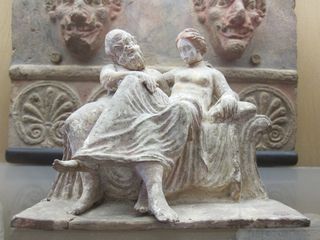
The idea of the "fake" has for some years been fashionable in classical archaeology. What's the difference between a "copy" of a sculpture (made by a enthusiastic eighteenth century sculptor) and a "forgery" (made by an equally enthusiastic and skilled sculptor -- but one who was intending to pass it off as "real")? And how do we deal with all those many pieces of "ancient" works of art, that have a bona fide ancient torso, but arms and legs courtesy of Bernini etc? To put it at its simplest, which part of the Museum do they belong in? (Sometimes, as with the Commodus bust in the Getty, we cant actually agree whether the whole thing is ancient or (early) modern..).
Anyway the "Jubilee Museum" (of the Musées Royaux d'Art et d'Histoire) in Brussels has a great little case which illustrates these issues rather nicely. It includes some obvious "souvenir" copies (like a tourist version of the sacrophagus of Scipio Barbatus), some equally obvious "fakes" -- though quite why anyone  should bother to make the weird little pig on the right, I haven't a clue.(It is supposed to be an object connected with an "Oriental Cult", and interestingly was given to the Museum by the famous Franz Cumont (it wasn't clear if Cumont knew it was fake or not).
should bother to make the weird little pig on the right, I haven't a clue.(It is supposed to be an object connected with an "Oriental Cult", and interestingly was given to the Museum by the famous Franz Cumont (it wasn't clear if Cumont knew it was fake or not).
But a particularly intriguing one was the little "Tanagra" figurine at the top. It had been thought "OK", and was now believed to be a late nineteenth-century fake. And it was interesting to think why . . . so far as I could see, it was mainly the subject matter: so close to the slightly flirtatious feel of some Tanagras, but at the same time so far (it was impossible quite to believe in that friendly satyr, putting his hand gently on the lady's knee..).
So far, so good. The trouble was that there were quite a few cases nearby without many labels in them, with apparently ancient objects on display. Or were they?
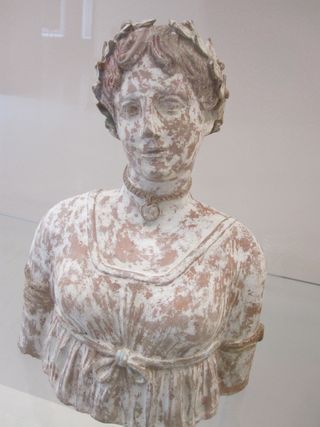
Once you had seen the "fakes" case, everything started to look not quite right. How about the rather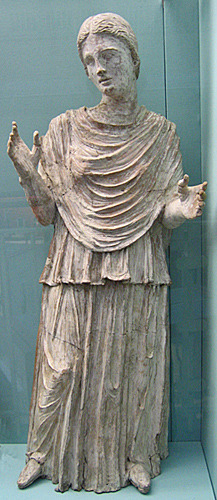 larger terra cotta above. There are things like this surviving from antiquity (some truly wonderful terracottas from Canosa, for example, which are not wholly different, as you see on the right). But is that necklace with its cameo quite right?
larger terra cotta above. There are things like this surviving from antiquity (some truly wonderful terracottas from Canosa, for example, which are not wholly different, as you see on the right). But is that necklace with its cameo quite right?
 And what about the little terracotta on the left. Again fine in a way, but on another look isnt it just a bit too NEO-classical?
And what about the little terracotta on the left. Again fine in a way, but on another look isnt it just a bit too NEO-classical?
They can't all be fakes, but once your suspicion has been aroused -- it spreads. Were they all waiting to be part of a big exhibition of fakes, and just hadn't got their labels yet?
But I dont want to give the wrong impression of the museum. There are lots of great classical things to see (and it's not exactly teeming with people). They have some great  little fragments of Roman painting from the Villa della Farnesina, as you see on the left.
little fragments of Roman painting from the Villa della Farnesina, as you see on the left. 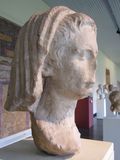
There's a classic Augustus (on the right), and a rather splendid later Roman bronze emperor, though his head doesn't belong (below on the left)
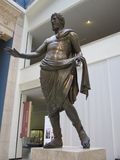 And if you are a fan of models (like I am), there is a great model of the ancient city of Rome, which almost rivals the Mussolini/Gismondi one at EUR.
And if you are a fan of models (like I am), there is a great model of the ancient city of Rome, which almost rivals the Mussolini/Gismondi one at EUR.
August 18, 2011
Why does the Manneken Pis?
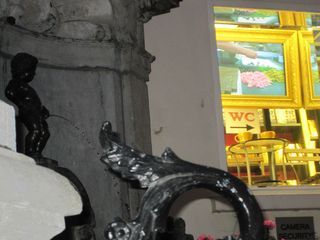
The icon of Brussels is (to judge from the souvenir shops at least) the bronze fountain/statue of the little boy pissing, the Manneken Pis. It is an image that, in Brussels, goes back to the seventeenth century; but the idea of a fountain spouting water as if it was peeing goes back at least to the Romans, and probably  before. It's not a hugely imaginative idea.
before. It's not a hugely imaginative idea.
Anyway, you can now buy battalions of this little guy, most made I guess in China (a few blazon "Made in Belgium", but most are not homegrown -- has anyone ever  gone to one of these Chinese factories where miniature images of the great monuments of the West are churned out?). And if you dont fancy a key ring, you can buy him in chocolate, or see him in a more than life size pretend-chocolate model. Every tour group is brought to admire.
gone to one of these Chinese factories where miniature images of the great monuments of the West are churned out?). And if you dont fancy a key ring, you can buy him in chocolate, or see him in a more than life size pretend-chocolate model. Every tour group is brought to admire.
 My question was: why has THIS become the icon of Belgium? Most cities have a much more visible symbol (Big Ben, the Parthenon, the Eiffel Tower), but this little boy is barely a metre tall and in what would have been a back street, if it hadnt been for him. He is supposed to go back to the early seventeenth century (stolen and broken up in the nineteenth, and remade from a mould of the pieces), and there are all kinds of urban legends about what he might stand for. The one I was told years ago was that he was a lost rich child, whose father vowed a statue of him doing whatever he was doing if and when he was found. But there are plenty of others. I rather like the ideas that it reminds us of the brave kids of Brussels who ensured their city's victory by pissing on the enemy from trees.
My question was: why has THIS become the icon of Belgium? Most cities have a much more visible symbol (Big Ben, the Parthenon, the Eiffel Tower), but this little boy is barely a metre tall and in what would have been a back street, if it hadnt been for him. He is supposed to go back to the early seventeenth century (stolen and broken up in the nineteenth, and remade from a mould of the pieces), and there are all kinds of urban legends about what he might stand for. The one I was told years ago was that he was a lost rich child, whose father vowed a statue of him doing whatever he was doing if and when he was found. But there are plenty of others. I rather like the ideas that it reminds us of the brave kids of Brussels who ensured their city's victory by pissing on the enemy from trees.
What I hadnt realised till we went last week was that he also had a wardrobe.

Kept in the Musée de la Ville de Bruxelles are the many and varied costumes he has been presented with by local and visting delegations. Where these are made, heaven knows.. but I have never seen the little chap dressed up.
Anyway, we couldnt resist going to see his kit when we were there last weekend. And as we going out of  the Museum we couldn't help notice some packs of what looked like repro 1950s postcards. These confirmed the sense of wonder -- because they foregrounded the sexuality of the image that most modern renderings would ostensibly disavow. OK they were sexualised only at one remove, but sexualised nevertheless. The repeated joke (as you can see; and it came in various forms) was the one about the middle-aged lady who sees the statue of the little boy, and suddenly gets horny.. to the distress of her middle-aged husband who sees that he is in for an energetic
the Museum we couldn't help notice some packs of what looked like repro 1950s postcards. These confirmed the sense of wonder -- because they foregrounded the sexuality of the image that most modern renderings would ostensibly disavow. OK they were sexualised only at one remove, but sexualised nevertheless. The repeated joke (as you can see; and it came in various forms) was the one about the middle-aged lady who sees the statue of the little boy, and suddenly gets horny.. to the distress of her middle-aged husband who sees that he is in for an energetic 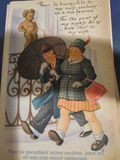 night.
night.
You coudn't sell these now. Or could you? And in what form? We imagined that we were buying repros of historic souvenirs. But getting them out on the train back home, they looked more like the real thing. There was nothing printed on the back about what they were copying, and the edges were decidedly yellow. Were they actually still flogging old stock?
And still no-one had quite explained why this pissing toddler was the icon of the city. Is it really just, as the guide books would claim, an encapsulation of the 'irreverent spirit" of Brussels.. a kind of Tin Tin avant la lettre?
August 14, 2011
The Africa Museum in Brussels -- and David Starkey
Even if you haven't read Adam Hochschild's King Leopold's Ghost, it's hard not to have picked up the point that Belgian rule in the Congo was terrible even on the usual standards of European colonialism in Africa. That said, I've always had a soft spot for the Royal Museum of Central Africa, just outside Brussels (and it has an honoured place on of my list of favourite but little-known museums -- a series I started several years ago on this blog and have been meaning to get back to).
I first visited this museum (in Tervuren, a quick tram ride from central Brussels) almost 10 years ago, with the daughter when she was doing a school project on the Congo. Then it was in its pristine state: it was a museum of itself, 'celebrating' the Belgian 'achievment' against the African 'savages'. Pride of place went to the statues in the front hall, large gilded personifications of kindly Belgium bringing peace,  prosperity and civilisation to the grateful Congolese (as you see at the top of this post, in the statue of the look-alike Leopold clutching the African kids to his breast, and on the right with Mother Belgium doing much the same) -- but the early nineteenth century display of colonial memorabilia told a similar story. Stanley emerged as almost as much of a hero as Leopold, and the Heart of Darkness was nowhere to be seen.
prosperity and civilisation to the grateful Congolese (as you see at the top of this post, in the statue of the look-alike Leopold clutching the African kids to his breast, and on the right with Mother Belgium doing much the same) -- but the early nineteenth century display of colonial memorabilia told a similar story. Stanley emerged as almost as much of a hero as Leopold, and the Heart of Darkness was nowhere to be seen.
A few years later we went again, and things were on the move -- for the worse I couldn't help feeling. There were glimpses of post-colonial political correctness appearing in the galleries which, understandable as they were, were so against the grain of the collection and its display (the whole thing had been put together under the auspices of Leopold himself for heaven's sake) that they risked looking faintly silly. They were in fact a bit like the new wave at the Natural History Museum in London, with its pious little notices about how we wouldn't hunt and stuff wild animals these days. It seemed to me that it would have just been better to leave the whole thing as it was and let us see what the colonial vision was like straight, and allow us to make our own minds up.
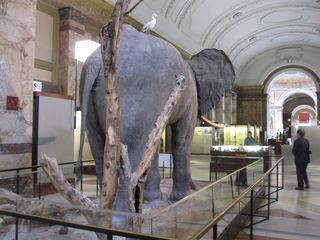
Anyway, I went back (with the husband and the son) this weekend and was prepared for the worst, I fully expected computer screens and interactive push buttons... "The Belgian intervention in the Congo was: (a) good or (b) bad)", with a serious computerised ticking off to anyone stupid enough to press button (b).
 Actually, it turned out to be a nice suprise. For quite a lot of the early twentieth century display had been rather carefully, and self-awarely, restored. As you can see, I hope. True, this was mostly in the natural history parts of the museum (despite the difficulties that you find in South Kensington, it is rather easier to come to terms with the colonial treatment of elephants than the colonial treatment of human beings). But even in the historical sections, a good deal of the post-colonial points were being made by adding sharp twenty-first responses to the traditional displays. There was, for example, a great photographic exhibition contrasting pictures taken in the Congo under
Actually, it turned out to be a nice suprise. For quite a lot of the early twentieth century display had been rather carefully, and self-awarely, restored. As you can see, I hope. True, this was mostly in the natural history parts of the museum (despite the difficulties that you find in South Kensington, it is rather easier to come to terms with the colonial treatment of elephants than the colonial treatment of human beings). But even in the historical sections, a good deal of the post-colonial points were being made by adding sharp twenty-first responses to the traditional displays. There was, for example, a great photographic exhibition contrasting pictures taken in the Congo under  Belgian rule with pictures taken now. In fact this was part of a project which tried to gather
Belgian rule with pictures taken now. In fact this was part of a project which tried to gather  contemporary Congolese reactions to old colonial photos -- something the daughter is wanting to do in South Sudan. (The image on the left is of two kids standing on the ruins of the kind of 'geodectic marker' that the Belgian on the right leans against.)
contemporary Congolese reactions to old colonial photos -- something the daughter is wanting to do in South Sudan. (The image on the left is of two kids standing on the ruins of the kind of 'geodectic marker' that the Belgian on the right leans against.)
All the same, the most dramatic impact in the museum is still the front hall, with those gilded statues of Belgian benificence to the benighted natives (even if some of them are now awkwardly -- or conveniently -- hidden  behind the coat lockers). What strikes me, looking at these, is not the fact that some of the Belgian administration (and for 'Belgian' you could read 'British') must have been well aware that paternalism was a convenient cover for exploitation. I am sure that was sometimes the case; but more often the Belgian bourgeoisie must
behind the coat lockers). What strikes me, looking at these, is not the fact that some of the Belgian administration (and for 'Belgian' you could read 'British') must have been well aware that paternalism was a convenient cover for exploitation. I am sure that was sometimes the case; but more often the Belgian bourgeoisie must  have turned up to this Museum and genuinely felt that it was a testament to their country's good works.
have turned up to this Museum and genuinely felt that it was a testament to their country's good works.
Which is to say that the interesting historical question (and one that the decor of the Brussels Museum raises emphatically) is not whether colonialism/empire was good or bad; but how we can start to understand how it seemed morally good to so many ordinary, decent western people. Self interest isn't a good enough answer. But there is an unimaginable leap of historical empathy here.
Those were the thoughts on the tram back to the hotel, where we caught up with the new Starkey row, which was not entirely unconnected. If I have got the story right, Starkey was in trouble for saying that if you heard David Lammy on the radio you would think he was white. Starkey seems to have thought this somehow to Lammy's (or the country's) discredit, whereas I felt that it was probably something to celebrate that you couldnt tell a black from a white voice on Radio 4 (or alternatively that, as always in Britain, it was class not race that was audible).
Lammy was to start with pretty restrained in his reply, but eventually came out with words to the effect of "Starkey should stick to sounding off about the Tudors". The objections to this were obvious. Starkey might be a rather undistinguished example of the genre -- but the Brussels Museum makes the powerful case that we DO need historians thinking and speaking about exactly these issues of race and ideology.
August 11, 2011
The Cambridge Chancellor election -- in 1847
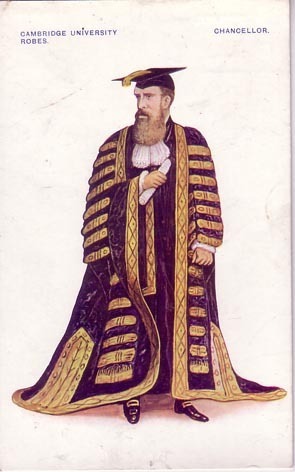
I haven't been to the Manuscripts Room of the University Library for a year of so (chance would be a fine thing). So I hadn't caught up with the new policing regime that I found when I showed up there this week: you now have to sign in on a separate admissions list, and you aren't allowed to take in even the small size bags that are allowed into the rest of the Library; instead you have to leave it in a locker outside. . . and you end up having to get the key back (because, wisely maybe, they dont trust you to keep the key on your person) every time you want to get 25p to buy a new pencil, or whatever.
I'm sure that this is all very sensible, and a good way of protecting the collection. But it does have a nasty way of criminilising you, and of raising the uncomfortable possibility that you and every other reader in the room might be liable to snitch some precious document as soon as anyone's back might be turned. (I wonder how many people it pushes to crime, at the same time as it makes it harder for them.)
Anyway, I was not to be put off, as I was there on the search of more things about the history of the Fitzwilliam. One thing I wanted to get to the bottom of was the celebrations in 1842 in honour of the new chancellor, the Duke of Northumberland, part of which took place in the Museum before the building ad even been finished. Just HOW unfinished I wondered.
One likely looking document was catalogued as the description of the election and installation of about 5 new Chancellors over the course of the nineteenth century, a manuscript written by eager, obsessive and rather smart nineteenth-century bureaucrats, keen to pass on the proceedings to their successors.
It turned out not to have anything to help me about the state of the Fitzwilliam in 1842, but it had lots of juicy stuff about the election of 1847 -- which turned out to have quite a lot in common with the election we are to have in October.
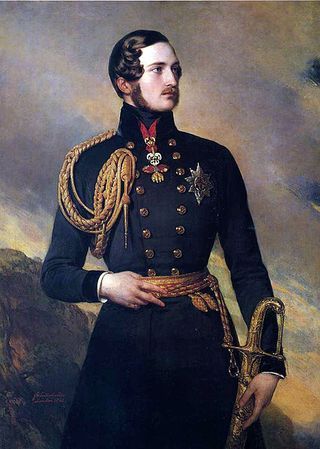
As I vaguely recollected (but it was brought vividly to life by this carefully written account), the establishment candidate in 1847 was Prince Albert (above) -- but, against him, the awkward squad, largely based in St John's, put up a rival in the shape of the Earl of Powis (a truly awful Tory, MP for Ludlow, and died in the wool opponent of the 1832 Reform Act).
After a bit of a wobble the Prince did not actually withdraw and went through with a lively election, which offers a load of tips for the supporters of the rival candidates this time round... including organising committees, and specially chartered trains from London to bring the voters in. (One of the things that the Prince's opponents worried about was that he would try to Germanise the University -- another was that the backdoor connection between University and crown was a bit unseemly.)
It appears to have been a spirited fight, with Albert winning comfortably but not by a huge majority. The anonymous bureaucrat of my document then lavishes his pen on the dinner held at the palace to celebrate the successful election (silver knives and forks for the first course, he insists, gold for the dessert..). Apparently the Earl of Powis was invited but couldn't come.
Which all makes you wonder about how the victory of Lord Sainsbury, the Mill Road hero, Brian Blessed or Michael Mansfield might be celebrated in October. Not so extravagantly, I guess, but I'll let you know.
(On another question, the big backer of Albert was W. Whewell, the Master of Trinity, who a few years later got into trouble for re-hanging the Fitzwilliam pretty much on his own over the Christmas holidays. One of his excuses was that he needed to put the nudes in less prominent positions... does anyone know of other examples of that kind of thing in the 1850s?)
August 8, 2011
In "hairdresser country"

Today I made a rare visit to the hairdresser. I rather like my unkempt look, but there is a fine line between idiosyncratic eccentricity and wild barbarity -- and things were verging on the barbarous.
Even so, I have a bit of a phobia of the salon. It's the terror of humiliation. Looking at my hair, the stylist is likely to utter the capillary equivalent of the usual plumber's line -- "what cowboy put that in?". Worse, I always think, they might then take things into their own hands. I go in to have a trim, and come out with a trendy cut, ten inches shorter. Once they get the scissors out, how do you stop them?
But, I am about to do a new tv mini-series, and felt the need of a little tidy up. All the same entering the salon is a little bit like entering a country whose language you don't speak very well.
For a start there is the choreography. Everyone else seems to know that (and when) you move from one chair to another. I wasn't sure, when I sat down at one basin and was then asked to move to another, whether this was planned (you have the towel put on here, then move over there) or whether the tap wasnt working at the first one.
Then, there are the questions. Experience in foreign languages suggests that you can only answer someone's questions confidently if you already know what they are likely to be asking you anyway. Otherwise 'yes' is the default response. I think I said 'yes' to the question about the water being the right temperature and the one about the pressure of the scalp massage, but I'm really not sure. (As for the question, "how would you like your hair dried".. that floored me; 'just dried'....)
And what about the stylists. Mine was very nice and not a pushy talker (phew). But was she really called "Olivia" and were her colleagues really called "Gemma" and "Amber"? Or are these "noms de salon"?
Anyway, I escaped rather pleased with the result (what do they do to make your hair seem so soft?) And not too much was removed (thank you Olivia). Maybe I'll go again in another 12 months.
August 5, 2011
What do e-petitioners want? Not the death penalty.

If you had listened to the news last night, you would have been under the impression that the government's new(ish) e-petition scheme was shortly to be landing us with another full scale House of Commons debate on the restoration of the death penalty. It was echoed over the world and in this morning's papers. There was a mixture of glee on the one side and other other (mine) some shaking of heads about the consequences of government by click.
The point about democracy is not that we take every silly idea seriously , it is that we take every worthy idea seriously -- and that those should not be the ideas of the rich or the privileged or the men or the old, but ANYONE's ideas. That's what's democratic about it. Democracy isn't something done at your lap top after a glass or two late at night (even the Athenians wouldnt have liked that... and even a referendum should demand you making some effort, with the rival positions laid out for consideration).
But may be we shouldnt have worried quite so much. When I got onto the site this morning, it wasnt quite as I had been led to believe. True, there were over 40 petitions calling for the return of the death penalty for various shades and varieties of murder (by paedophiles, by Class A drug dealers, of children or police...) in various shades of muddle:
Try this:
"Restoration of capital punishment for certain murders only is unacceptable. Capital punishment should be restored for all crimes of murder without exception. However, in conjunction with this, legal and court measures must be introduced to ensure that the innocent are not convicted of murder; it is better to let the guilty sometimes escape to ensure that none who are innocent shall be convicted."
(Like how...?)
Or this (providing an over-optimistic answer):
"RE-INSTATEMENT OF THE DEATH PENALTY. With new technologies and DNA etc, the excuse of getting the wrong person convicted is no longer applicable."
Compare this to the fact that there were no petitions at all submitted on areas covered by the Department of Education or the Department for International Development (which is itself one reason why government by petition is so dangerous).
But a second look offered a slightly different perspective. So far, more people have signed up AGAINST the death penalty than FOR.
On a quick calculation there were just over 6000 for some form of capital punishment, and almost 8500 against, albeit in far fewer individual petitions -- one of which had attracted 7300 signatures -- more than combined total of those wanting a return to hanging. (Either way it is still a long way from the 100,000 signatures required for consideration for debate in parliament . . .)
But an even closer second look suggested a signficantly different practice among the petition administrators across the different government department. Go to the petitions submitted to the Foreign Office, and you will find that 18 calling for some form of referendum on withdrawl from the EU have been rejected by the authorities on the grounds that "There is already an e-petition about this issue". So far (though perhaps the civil servants have not got to work with their electronic blue pencils) none of the various petitions for return of the death penalty have been rejected.
Maybe that is because the site administrators reckon that they really are significantly different: the man wanting death for paedophiles may NOT in fact want to hang Class A drug dealers (whereas, by contrast, everyone who wants an EU referendum wants much the same thing).
Or maybe there is something more subtle going on. As I understand the rule, an individual petition has to score at least 100,000 signatures in order to qualify for consideration for a debate. Could it be that the young mandarins in charge of this site are doing their quiet best to make sure that they dont reach that target). The divide and rule principle.
If so, I'm all behind them. But it somehow undermines the government hype on the scheme.
August 2, 2011
Size zero models: 1912

It comes as something of a relief to discover that people were objecting to waif-like images of women already 100 years ago.
I have spent a very happy day in the Fitzwilliam Museum, in their archive, investigating the early display of classical antiquities there. But, as always in real (as against a virtual) archive, you stumble across unexpected things.
Today that was a satirical story clipped out of a 1912 issue of the Cambridge student magazine, The Granta. Entitled "A tilt at the Fitzwilliam", it features a jocular student, "The Jester", and a woman he is walking out. Their first dilemma is whether to visit the Fitzwilliam (a picture gallery) or the local cinema (a picture house). Having opted for the Fitzwilliam, they don't have a great time.
The Jester points out to the girl that most of the good stuff on show is borrowed. You can find, he explains, "the most beautiful Nicholson woodblock (. . .on loan) among a whole crowd of Rossetti's languorous maidens -- these latter being on the permanent staff -- very poor and always with us".
But, objects the girl, "Oughtn't we to like Rossetti nowadays?"
"It's only done at Oxford," retorts the Jester, "not in artistic circles. You see no one except Rossetti, and a select crowd from 'the other place' ever saw a girl like that. And they never saw it themselves really. However, they're trying to show you what you ought to be like -- a protest against the standard pattern you're manufactured on."
Which seems to me as close as you can get to talking about body-image role-models in 1912.
Much of the rest of the story is of course a little bit more remote. The Jester soon launches off into his own view of art and representation. "There is hardly a picture that shows us what we really see -- always what someone -- probably the painter, and Dutch at that in most cases -- thinks we ought to see." And this in turn, becomes an excuse for old-fashioned Oxbridge snobbery: "A picture can be as pedantically correct as you like, but unless it has somethimg in it that makes you say "I've seen that," or "I know that it's the real thing," it is absolute passive and only fit to be hung in a sleek Aldermanic drawing room."
So, asks the girl, "How would you reform it?"
"Sell ninety percent, and with the proceeds buy a few good pictures." And more or less with that, they quit the Museum and make for the Picture Palace, in the other sense.
But for me a nice tilt at pre-Raphaelite skinny women (which we plastered on our walls in the 1970s).. and it reminds me of Vernon Lee's Miss Brown, which I havent read for ages for had a go -- if I recall rightly -- at the sexual exploitation of pre-Raphaelite models by pre-Raphaelite artists.
Mary Beard's Blog
- Mary Beard's profile
- 4110 followers





